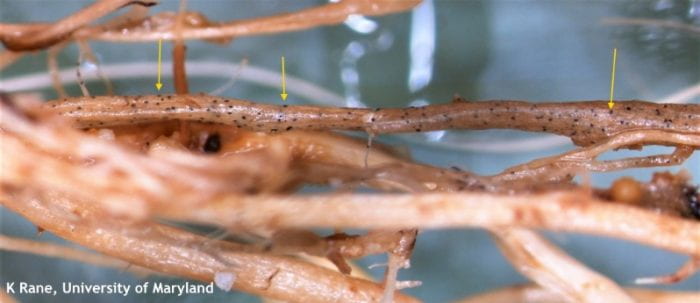A root disease that is most commonly associated with potato has turned up on tomato in a high tunnel. This disease goes by the delightful name of black dot root rot. The causal agent is Colletotrichum coccodes, which also causes anthracnose fruit rot on tomato (sunken, water-soaked, circular lesions).
C. coccodes infection on tomato roots appears as lesions on the root surface that produce black microsclerotia (the ‘black dot’ in its name) (Fig. 1). Infected plants will sometimes wilt with the lower and middle leaves of the plant turning yellow.
C. coccodes has a very large host range, which includes members of Solanaceae, Cucurbitaceae and Leguminosae, both crops and weeds. Nightshade in particular (a solanaceous weed) can harbor the fungus, often without showing symptoms. The pathogen can survive in the soil for up to eight years as microsclerotia.
This pathogen causes problems only under poor growing conditions or when other pathogens are present. The disease occurs in greenhouses or high tunnels where there has been a continuous cropping of tomato for several years, resulting in very high levels of inoculum. Other conditions that can be encountered in high tunnels, such as high soluble salt levels, low pH, low or excessive fertilization, high temperatures and water stress, can predispose plants to infection and root rot by C. coccodes. These infected plants can at times show few symptoms, but still be responsible for yield reductions.
The disease can be prevented by growing in optimal conditions for tomato in the high tunnel. Deep plowing (12-15 inches, not easy to do in a high tunnel we know) degrades infected plant debris more rapidly and buries propagules both of which may help reduce fungal populations. Steam sterilization of the soil can greatly reduce disease incidence.
Crop rotation is another tried and true management plan if growers can rotate out of any solanaceous, leguminous or cucurbit crops for 3-4 years – something most growers probably cannot financially do. Grafting is another possibility, but even grafted plants can still become infected with this disease. A particular root stock may be resistant or more tolerant of the disease, but this is something that would need to be checked before using. Small grain or corn can be used in rotation to reduce fungal populations.
– Jerry Brust, IPM Vegetable Specialist, University of Maryland
Figure 1. Black dots (microsclerotia of C. coccodes, arrows) on tomato root. Photo: K. Rane/University of Maryland















